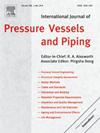617合金高温蠕变和拉伸行为的弹粘塑性模型多目标标定
IF 3
2区 工程技术
Q2 ENGINEERING, MECHANICAL
International Journal of Pressure Vessels and Piping
Pub Date : 2025-05-26
DOI:10.1016/j.ijpvp.2025.105566
引用次数: 0
摘要
高温工程系统需要在持续的热负荷和机械负荷下运行,同时还要经历反复的热瞬变。因此,开发能够准确预测材料在一系列载荷和温度条件下的行为的材料模型至关重要。本研究提出了半经验弹粘塑性(EVP)模型的多目标校准框架,旨在同时捕获合金617在800°C, 900°C和1000°C下的蠕变和拉伸行为。使用多目标遗传算法(MOGA)开发了一个三阶段的校准工作流程,以确定两个基于evp的模型的统一材料参数集:(i)一个包含经典蠕变损伤(EVP-CD), (ii)另一个包含基于工作的损伤(EVP-WD)。两种模型都使用短期高温蠕变和拉伸数据集进行校准,同时根据给定温度下获得的长期蠕变数据集进行验证。结果表明,校准后的材料模型可以同时捕捉高温蠕变和拉伸行为。值得注意的是,EVP-WD模型在再现失效时的完整拉伸应力-应变响应方面表现出更好的准确性,尽管校准难度较大。提出的方法为开发适用于多种使用条件的单一材料模型铺平了道路,从而简化并提高了高温工程部件的使用适用性评估的准确性。本文章由计算机程序翻译,如有差异,请以英文原文为准。
Multi-objective calibration of elastic-viscoplastic models to capture the elevated-temperature creep and tensile behaviour of alloy 617
High-temperature engineering systems are expected to operate under sustained thermal and mechanical loads while also undergoing repeated thermal transients. Consequently, it is essential to develop material models capable of accurately predicting behaviour under a range of loading and temperature conditions. This study presents a multi-objective calibration framework for semi-empirical elastic-viscoplastic (EVP) models, aimed at simultaneously capturing the creep and tensile behaviour of Alloy 617 at , , and . A three-stage calibration workflow was developed using a multi-objective genetic algorithm (MOGA) to identify a unified set of material parameters for two EVP-based models: (i) one incorporating classical creep damage (EVP-CD), and (ii) another incorporating work-based damage (EVP-WD). Both models were calibrated using short-term high-temperature creep and tensile datasets while their validation was performed against longer-term creep datasets obtained at a given temperature. The results demonstrate that the calibrated material models can capture both high-temperature creep and tensile behaviour. Notably, the EVP-WD model exhibited better accuracy in reproducing the full tensile stress-strain response to failure, albeit with greater calibration difficulty. The proposed approach paves the way for the development of a single material model applicable to multiple service conditions, thereby simplifying and improving the accuracy of fitness-for-service assessments of high-temperature engineering components.
求助全文
通过发布文献求助,成功后即可免费获取论文全文。
去求助
来源期刊
CiteScore
5.30
自引率
13.30%
发文量
208
审稿时长
17 months
期刊介绍:
Pressure vessel engineering technology is of importance in many branches of industry. This journal publishes the latest research results and related information on all its associated aspects, with particular emphasis on the structural integrity assessment, maintenance and life extension of pressurised process engineering plants.
The anticipated coverage of the International Journal of Pressure Vessels and Piping ranges from simple mass-produced pressure vessels to large custom-built vessels and tanks. Pressure vessels technology is a developing field, and contributions on the following topics will therefore be welcome:
• Pressure vessel engineering
• Structural integrity assessment
• Design methods
• Codes and standards
• Fabrication and welding
• Materials properties requirements
• Inspection and quality management
• Maintenance and life extension
• Ageing and environmental effects
• Life management
Of particular importance are papers covering aspects of significant practical application which could lead to major improvements in economy, reliability and useful life. While most accepted papers represent the results of original applied research, critical reviews of topical interest by world-leading experts will also appear from time to time.
International Journal of Pressure Vessels and Piping is indispensable reading for engineering professionals involved in the energy, petrochemicals, process plant, transport, aerospace and related industries; for manufacturers of pressure vessels and ancillary equipment; and for academics pursuing research in these areas.

 求助内容:
求助内容: 应助结果提醒方式:
应助结果提醒方式:


